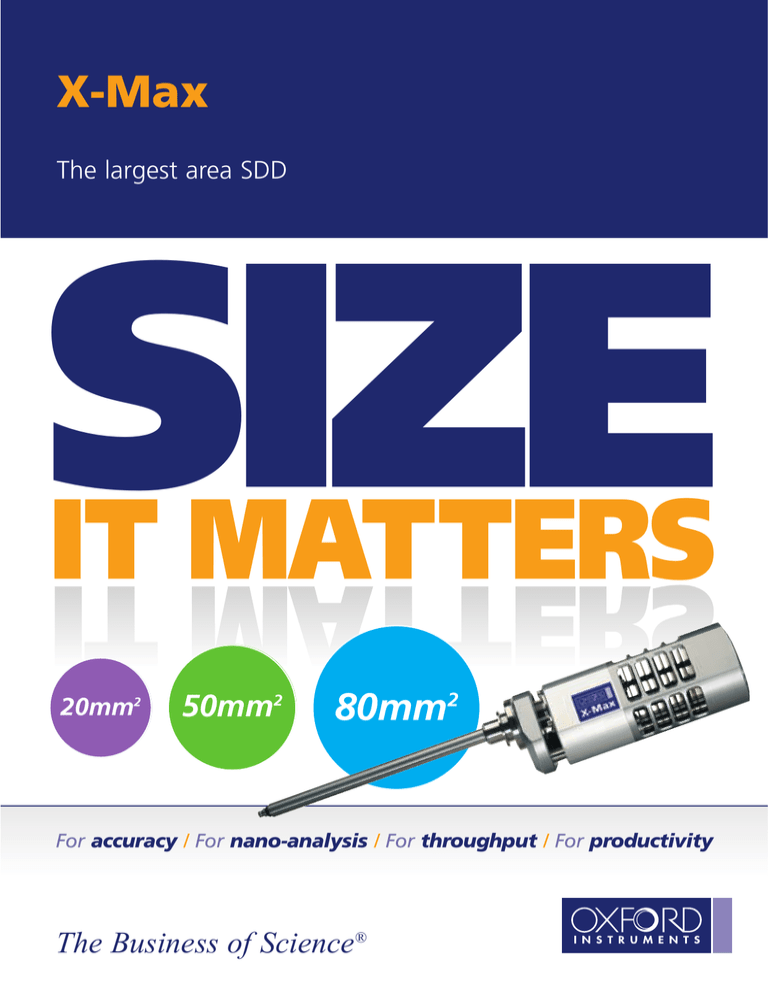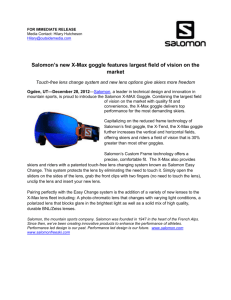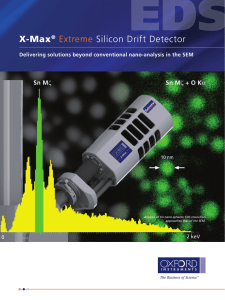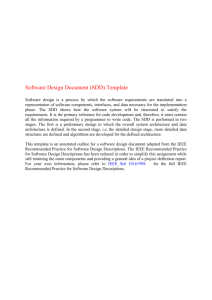
X-Max
The largest area SDD
SIZE
IT MATTERS
20mm2
50mm2
80mm2
For accuracy / For nano-analysis / For throughput / For productivity
The Business of Science®
X-Max
Large area SDD
Analysis with a large area
analytical SDD benefits from:
A traditional 10mm2 detector has a small capture angle = fewer counts
A modern large area detector has a large capture angle = many counts
• Simultaneous imaging and analysis without
compromise
• Large active area with superb analytical resolution
• Practical nanoanalysis at productive count rates
• High count rates, even at low kV
• High count rates, even at small spot sizes
• The correct results
20mm2
80mm2
50mm2
X-Max delivers:
Resolution Versus Sensor Size
• Up to 1,000% greater productivity
200 eV
• Real 200,000 cps analysis
190 eV
• Usable nanoscale analysis
Projected
resolution of
traditional SDDs
180 eV
• MnKα resolution down to 123eV - even at 80mm
170 eV
Resolution at MnKα
2
160 eV
Actual resolution
of traditional SDDs
150 eV
Actual X-Max
SDD resolution
140 eV
130 eV
120 eV
110 eV
100 eV
10
20
30
40
50
Active Area
Traditional SDD
X-Max SDD
X-Max The largest area SDD
60
70
80
90
X-Max
Productivity and accuracy combined
20mm2, 50mm2, and 80mm2 SDDs with identical world-beating
analytical performance
Now you can have count rate,
imaging, and analytical
performance all at the same time:
No resolution compromises with large area SDDs
8000
80mm2
MnKα
7000
• Up to 80mm active area
2
6000
• Count rates > 500,000 cps
5000
Counts
• Throughput > 200,000 cps
• MnKα typically 125eV
50mm2
4000
125eV
3000
125eV
2000
Maximum counts from larger
detectors with increased
solid angle:
20mm2
1000
MnKβ
125eV
0
5
5.2
5.4
5.6
5.8
6
6.2
6.4
6.6
6.8
7
Energy (keV)
• Count for less time - increase productivity
• Or count for the same time and get more precise results
• Or gather data at much lower beam currents meaning:
• No sample damage
• Longer filament tip lifetimes
• Reduced contamination
X-Max analytical SDDs offer
the best solution for
productive analysis
• Better spatial resolution
• Practical nanoanalysis with productive count rates at
low accelerating voltages
X-Max features
• Unique large area SDD sensors
• Discrete PentaFET® design - accuracy at
all sizes
• Sensor enclosed in self-contained vacuum
assembly - no oxygen X-ray absorption
• Unique electron trap for maximised
solid angle
• Only one pulse processing channel
required
• Tube diameter no bigger than a 10mm2
SIZE
IT MATTERS
X-Max
Large area SDD
Why size matters
Count rate (cps)
0
50,000
100,000
150,000
200,000
0
2
4
Zone of improved
accuracy AND
productivity
80mm2
Zone of
improved
accuracy
Beam current (nA)
6
50mm2
8
10
12
Zone of increased
productivity
14
16
Normal SDD
operating zone
18
10mm2
20mm2
20
Discover the benefits of working with large SDDs.
X-Max The largest area SDD
Previously, users had to chose between:
1. Working at low beam currents to maintain accuracy
2. Working with high beam current to get high count rates, risking beam
damage and contamination
Now X-Max offers users two more options:
3. Work at low beam currents with high count rates and improved accuracy
4. Or decrease analysis times
X-Max
Size and productivity
Benefit immediately with increased counts from X-Max
These almandine garnet
spectra were collected
using a 10mm2 SDD
detector and the new
20mm2, 50mm2, and
80mm2 X-Max detectors.
The larger X-Max
detectors collect more
X-rays under the same
collection conditions.
Massively improved productivity
1000
80mm2
FeKα
900
800
Relative Intensity
700
50mm2
600
500
400
20mm2
300
CaKα
200
CaKβ
100
K Kα
MnKα
10mm2
0
3.2
3.7
4.2
4.7
5.2
5.7
6.2
6.7
7.2
7.7
Energy (keV)
True 100,000 cps performance
Many more analyses can be performed with 80mm2 detectors at 100,000 cps
Beam current needed to generate 100 kcps
Beam current needed to achieve 100,000 cps
100 nA
10mm2
20 nA
Maximum beam current
for many FEG-SEMs
5 nA
Upper limit of typical
operating conditions
for most SEMs
10mm2
10 nA
80mm2
80mm2
1 nA
This logarithmic scale bar chart shows how high
the beam current needs to be to achieve 100kcps
on a traditional 10mm2 SDD at 5kV and 20kV. It is
a ten-fold increase over what is required to
generate the same count rate on a new X-Max
80mm2 SDD detector.
20 kV
5kV
Accelerating Voltage
SIZE
IT MATTERS
X-Max
Large area SDD
The effect of beam current on analytical data
Data collected with standard 10mm2 SDDs
Insufficient data for usable nanoanalysis
High beam current reduces accuracy
■ Ni
■ Cr
■ Nb
■ Ni
■ Cr
■ Nb
10mm2
10mm2
Current low
Accuracy OK
Counts low
✓✓✓
✓
✗✗✗
Some detail but very few counts
Data collected with a 10mm2 detector for 45 minutes at 3.3nA.
Insufficient data has been collected which means a poor map that is
not usable for analysis.
Current high ✗ ✗ ✗
Accuracy low ✗ ✗ ✗
Counts high ✓✓
Lots of counts but no detail
Data collected with a 10mm2 detector for 45 minutes at 36nA. The map
shows lots of counts but the detailed information is blurred by a large
spot size at this current.
Lots of counts and high quality data at low
beam current
■ Ni
■ Cr
■ Nb
Data collected
with 80mm2
X-Max SDD
80mm2
Current low ✓✓✓
Accuracy High ✓✓✓
Lots of counts ✓✓✓
X-Max The largest area SDD
Lots of detail AND lots of counts
Data collected with an 80mm2 detector for 45 minutes at 3.3nA. The
mix map shows good spatial resolution and contains lots of data for
good quantitative analysis.
X-Max
Size and accuracy
Larger detectors cause less surface damage
Increasing accuracy by
lowering accelerating
voltage
Beam damage on sensitive samples
X-Max offers unparalleled benefits
when working at low kV (and low
count rates).
20 kV
■ Ni
■ Cr
■ Nb
80mm2
10mm2
C
A
This image is of a polymer sample, taken at 0.2nA.
Features on the surface and striation from sample
preparation can clearly be seen.
B
The same sample imaged at 2nA shows extensive
surface damage and distortion as a result of the
higher beam current.
5 kV
Beam contamination
■ Ni
■ Cr
■ Nb
C
This image is of a sample
from a nickel spinner bowl.
Two areas have been
examined, the one on the
left using a large area
detector, the one on the
right with a traditional
10mm2 detector. To collect
the same data the sample
had to be exposed for ten
times longer with the
smaller detector and as a
result has far worse
contamination.
A
B
Maximise counts for accurate
nanoanalysis with X-Max
These two maps were collected from
the same area under the same
conditions, changing only accelerating
voltage. While superficially similar,
points A, B, and C are actually very
different. This is because reducing
accelerating voltage (kV) reduces the
interaction volume from which the
X-rays are generated. As a result, the
20kV map shows X-ray signals from
structures below the surface not seen
in the 5kV map. Analysing at low kV
benefits nanostructure analysis as it
means that X-rays are only collected
from the surface structures.
80mm2
10mm2
SIZE
IT MATTERS
X-Max
Technology leadership
Unique large area sensors
• Discrete PentaFET® design offers the following benefits:
• Protects FET from X-ray damage*
• Superior thermal design and FET gain stabilisation
means detectors cool quickly and stabilise fast
• Radial design for minimal ballistic deficit*
• Polycrystalline Si construction process for extreme
low leakage
Unique magnetic trap design
• Allows large area sensor very close to samples
• Minimum sample to sensor distance = maximum
capture angle
• Typically 10 times greater than standard 10mm2 SDDs
• Uses optimised rare earth element design
* For more information about silicon drift sensor technology and
what makes an SDD detector analytical, go to www.oxinst.com/sdd
to request a free copy of ‘SDD Explained’
X-Max The largest area SDD
X-Max
Pushing the boundaries
Vacuum enclosed sensor
• No gas fill to absorb light elements
• Nitrogen gas in other SDDs absorbs oxygen and
other low energy X-rays
• Vacuum enclosure increases analytical accuracy
• Long lifetime design
• Uses OI vacuum technology
• Vacuum allows far greater cooling
• Dramatically reduces thermal noise in large
area SDDs
• Not possible with gas-filled systems
O Kα signal
O Kα
Detector
Window
O Kα
O Kα signal
SDD Sensor
Detector
Window
SDD Sensor
How does nitrogen gas affect oxygen
Nitrogen
Molecules
Nitrogen filled SDD detector
The oxygen X-rays are absorbed by the nitrogen
molecules present in the ‘vacuum’ so only a fraction of
the X-ray signal gets through to the sensor.
X-Max SDD detector
The oxygen X-rays are not absorbed as there is no
nitrogen present so you can see the true shape and
height of the oxygen peak.
On site 8-hour repair capability
• Includes window breakages
SIZE
IT MATTERS
X-Max
Applications
Low energy mapping of nano-particles
■ B
■ C
■ Ni
Ni
Cr
29 nm
Cr
C
Ni
X-Max achieves excellent resolution. It also allows the
user to do extraordinary nanoanalysis under conditions
where other detectors struggle to produce sensible
results. This means X-Max not only allows detection of
small precipitates, but can map them as well.
Very high count rate maps
Texture analysis of fracture surface of a granite sample.
This map, taken at a count rate of 400,000cps with an
X-Max 80mm2 detector, shows clearly how it is possible
to map the different chemical compositions of a rough
surface to see how the textured surface and chemical
composition of the surface relate to each other.
■
■
■
■
X-Max The largest area SDD
C
Al
K
S
■
■
■
■
Na
Ca
Si
Fe
Here we see a sample containing very small boride and
carbide precipitates. The map clearly distinguishes between
the different phases and even identifies the chemical
composition of precipitates as small as 30nm. The spectrum
above is from the highlighted 30nm carbide precipitate and
includes data equivalent to a 0.5 second acquisition.
X-Max
Superb performance
Why does an X-Max EDS system give such exemplary performance?
• A great detector
• Maximum real active area
• Excellent resolution at high and low energies
• Good throughput
• ISO15632:2002 resolution compliance
• Excellent electronics
• Highly linear analogue to digital conversion
• Good rejection of simultaneous events (Pulse-pile-up)
• Excellent signal to noise ratio
• < 1eV change in peak resolution and position between
1 and 100,000cps
• Unique OI-owned interpretation algorithms
• Complete - and correct - database of X-ray lines and edges
• Software correction of sum-peaks
• Highly accurate deconvolution, AutoID, and Quantitation
What the system doesn’t have:
• Shelf, tail, and shift correction - only real data is
analysed
• Fan cooling - no vibration
• Forbidden elements - all elements from Be to Pu can
be analysed
• Identification of absent elements - no false positives
Mn
123eV
Mn
Mn
Mn
C
At 80mm2, X-Max gives Mnkα resolution that other SDDs can't match.
Here we see 123eV; 6 eV better than the guaranteed specification of
129eV.
(Spectrum courtesy of P Russell, Appalachian State University.
Recorded at 20kV, 168pA).
X-Max
For accuracy / For nano-analysis / For throughput / For productivity
SIZE
IT MATTERS
Oxford Instruments
NanoAnalysis
X-Max
UK
Halifax Road, High Wycombe
Bucks, HP12 3SE England
Tel: +44 (0) 1494 442255
Fax: +44 (0) 1494 524129
In practice
Email: nanoanalysis@oxinst.com
China
Shanghai
Tel: +86 21 6360 8530/1/2/3
Fax: +86 21 6360 8535
Email: na.sales@oichina.cn
France
Saclay, Cedex
Tel: +33 (0) 1 69 85 25 24
Detector area
20mm
50mm
2
80mm
2
2
Fax: +33 (0) 1 69 41 86 80
Email: analytical-info@oxford-instruments.fr
Resolution (eV):
Germany
MnKα resolution
129
Operating angle
0 to 45
Temperature range
10oC to 30oC
Email: nanoanalysis@oxford.de
Altitude
Sea level to 1,500m
Japan
o
129
129
Wiesbaden
Tel: +49 6122 937 176
o
Fax: +49 6122 937 175
Tokyo
Tel: +81 (0) 3 5245 3591
Fax: +81 (0) 3 5245 4466/4477
Email: nanoanalysis@oxinst.co.jp
Comparison of detector type
Latin America
Concord, MA, USA
Si(Li)
Other SDD
X-Max
Tel: +1 978 369 9933
LN2-free
NO
YES
YES
Fax +1 978 369 8287
Maximum single sensor active area
30mm2
30mm2
80mm2
Email: nanoanalysis@ma.oxinst.com
Singapore
Typical analysis conditions for most productive count rate
Tel: +65 6337 6848
Fax: +65 6337 6286
Spot size
Small
Large
Small
Beam current
Low
High
Low
instruments.com.sg
Accuracy at low kV
High
Low
High
Sweden
Maximum throughput
Low
High
High
Productivity at low beam currents
Low
Low
High
Email: nanoanalysis@oxford-
Lidingö
Tel: +46 8 544 81550
Fax: +46 8 544 81558
Email: nordiska@oxinst.com
USA - Oxford Instruments
Concord, MA, USA
Tel: +1 978 369 9933
Oxford Instruments, at High Wycombe, UK, operates Quality Management Systems approved to the requirements of BS EN ISO 9001. This publication is the
copyright of Oxford Instruments Analytical Limited and provides outline information only which (unless agreed by the company in writing) may not be used,
applied or reproduced for any purpose or form part of any order or contract or be regarded as a representation relating to the products or services concerned.
Oxford Instruments’ policy is one of continued improvement. The company reserves the right to alter, without notice, the specification, design or conditions of
supply of any product or service. Oxford Instruments acknowledges all trade marks and registrations.
© Oxford Instruments Analytical Ltd, 2008. All rights reserved.
Part no: OIA/160/A/0908
As part of Oxford Instruments’
environmental policy this brochure
has been printed on FSC paper
Fax +1 978 369 8287
Email: nanoanalysis@ma.oxinst.com
www.oxford-instruments.com





